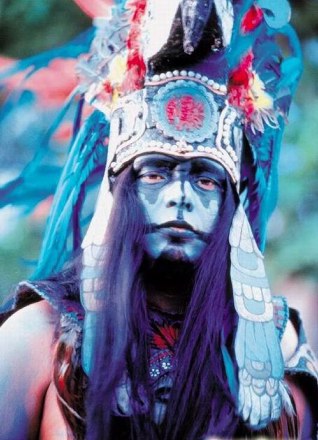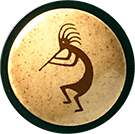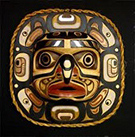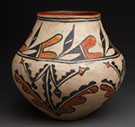

The Talking Cross of Chan Santa Cruz (Tixcacal Guardia)
The Yucatan's Caste War pitted the Mexican aristocracy and the Roman Catholic Church against a rebelling Maya people, long enslaved, always overtaxed and constantly tortured into submission. It was on the advice of a 'talking cross' that the Maya found the strength to join forces to fight for freedom and independence ...
By Logan Hawkes
Deep in the heart of the lowlands of the Yucatan peninsula, travelers often encounter the remnant population of the once-great Mayan civilization, the very descendants and survivors of kings and rulers of former empires. For the most part, the contemporary Maya who populate this densely forested region live simple lifestyles, generally in grass-roof huts with dirt floors. They still farm and fish and hunt in order to carve out a living in the unforgiving jungle heat. Sadly, for most of them, much of their history has been lost, burned by zealous servants of the Roman Catholic Church and their Spanish cohorts who came to the New World to conquer the 'pagans of the West' and to convert them to the one true faith.
Before living and working in Mexico's Yucatan Peninsula back in the 80s, I had very little knowledge of the local history or culture of the region and knew even less about these noble natives. But it didn't take long for these humble and generous people, and their

amazing past, to hypnotically capture my attention, admiration and imagination. I only needed to walk through my first set of ancient and mysterious ruins to know that I wanted to know all I could about the past of this unusual and talented culture who, on the outside, appeared very humble and nearly primitive.
As a native of Texas I remember reading once, and was interested in, the story about the young Texas Republic (1836-1842) who sent naval war ships to the Yucatan coast to aid the indigenous Maya in their fight for independence from the notoriously brutal Mexican militaristic government. Texas had, after all, experienced their own troubles with the young Mexican federation, and in their new independence were apparently eager to help the Maya, or anyone one else struggling with the Mexicans, in any way they could. I assumed the Republic was willing to help for political reasons. But after being charmed myself by these rather shy and remarkable people, I am no longer certain that Texas wasn't willing to help simply because of the simplicity and innocence of the mild mannered Maya, coupled with their unbelievable human struggle against the tyranny and hardships they suffered.
Regardless, armed with little more than a backpack, a map and a Jeep I had driven down from the States, and feeling a lot like Indiana Jones, at least in my mind, I struck out across Quinatana Roo and Yucatan states in search of ancient ruins and answers to the many mysteries of the Maya that had been racing through my brain. This was going to be a real adventure.
I had purchased and read Stephens and Catherwood's "Incidents of Travel in Yucatan". I filled my bag with a half dozen other books about the Maya and used them to plot a course across the region in search of the lost history of the Maya. What a road trip!
I was amazed that the Maya, in the peak of their glory (around 700 AD), populated massive and sophisticated city-states adorned with colorful pyramids and intricately carved temples and stone relief. They had mastered a complex calendar system, were proficient in math and astronomy, and had organized complex governing systems based upon the spiritual order of the cosmos. I also found it interesting that they had apparently abandoned these great cities and returned to the jungles for no obvious reason. Their civilization had failed it seemed, and I wanted to know why.
It was along the way that I first heard about the Caste War and the legend of the Talking Cross and the many events that finally led to the organized Mayan rebellion against European and Mexican national oppression.
To recap their history, it was in 1517 that the Spanish first arrived on the shores of the Yucatan. The brightly-clad arrivals were awed at the size and complexity of the Mayan cities. But it didn't take long for the Spaniards to begin to depersonalize the Maya, and to systematically destroy their native identity, forcing their own Hispanic culture on these simple people in the name of God. Mayan books and idols were burned. Great works of art that told their ancient history were destroyed. The Spanish language, culture and way of life were imposed on the millions of New World colonial subjects, at least those that survived the sickness that came with the influx of Old World explorers. The ultimate goal, of course, was that the Mayan way of life was to be erased, and the Hispanic colony extended.
However, despite centuries of brutality and repression, the Spanish never fully succeeded in breaking the Mayan identity. There were many insurrections against the Spanish down through the years, eleven major uprisings between 1546 and 1761. Each of these were crushed by the Spanish forces. For over 80 years after the last insurrection, the Mayan people settled to a life of Hispanic domination.
In 1847 however, a new Mayan offensive was launched from the village of Tepich by two rebel leaders; Cecilio Chi from Tepich and Jacinto Pat from Tihosuco. The Mayan attack grew quickly and advanced at great speed. For the first time, the Mexican military and landowners were not able to suppress the offensive, which came to be known as the Caste War. It became one of the most violent conflicts in the history of the Mayan world and lead to the eventual freedom and restoration of the identity of the Maya.
But what helped unite the Maya to collectively oppose their enemy after so many ill attempts had failed? Former outbreaks of armed conflict were limited in size and scope and generally included one or two Mayan groups - not the Maya-at-large. Could it be, as legend has it, that it was the magic and influence of the Talking Cross that united the fragmented villages and tribes into one major war effort?
The mysterious Cross, which some said miraculously appeared in the jungle and spoke to the Mayan leaders, was believed to be a way in which God communicated. The Cross 'told' the war chiefs that the conflict should continue and that the people must be patient in their fight and better organized for the conflict.
The village of Chan Santa Cruz (Small Holy Cross) became the religious and political center of the Maya resistance thereafter, and the rebellion came to be infused with religious significance. Chan Santa Cruz also became the name of the largest of the independent Maya states as well as the name of the capital town (now the city of Felipe Carrillo Puerto, Quintana Roo). The followers of the Cross were known as "Cruzob".
The Maya rallied their numbers and marched on the colonial city of Merida. They had all but crushed the Mexican army, entrapping them within the walls of the city when, according to legend, something rather odd happened. Seeing swarming insects and experiencing heavy rains, the Maya warriors, who were foremost farmers, took this as a sign from the Mayan God Chac, God of rain, and apparently abandoned the fight in order to return home for the ritual of preparing and planting their crops of corn.
Sporadic resistance did continue, however, until 1901 when Mexico finally claimed control of the entire peninsula while conceding the cultural right of the Maya.
During my travels across the region I encountered a young medical student from Merida whose father was an honored Cruzob shaman. His enthusiasm over his native beliefs and my interest in them sparked many tales. The colorful stories and legends he told, as passed down from his father and grandfather and those before them, were magnificent and full of mystery and might. In short time our friendship bonded and I will always consider him a real friend. I had learned so much from his uniquely Mayan perspective, and armed with the stories and tales I had heard, I a
With his help, I have had the pleasure of visiting many historical ruins yet uncovered and many yet unexcavated. I was armed with his Mayan folk tales and the many legends he had related, and could look upon the ruined cities in a different light. I believed my friend and his father when they claimed that the Talking Cross was still in existence, and hidden away from the world for safe keeping. They told me the cross still talks, and even recently instructed the Mayan Elders to prepare for the ending of the current age and the beginning of the next.
Mayan religion and cosmology are mixed into a very complex system of spiritual enlightenment, and I can't pretend to comprehend it very well at all. While I can glimpse into their spiritual world and, at times, make some sense of it, I admit that in the end it is far over my head and level of understanding.
Nonetheless, the search was on. Was the Talking Cross an actual artifact still in the possession of the Maya spiritual leaders, and if so, where did they keep it? Was the Cross a hoax, as some claim, instituted by a renegade Mexican soldier-turned-rebel, designed to unify the scattered Maya into one war machine of armed resistance back in the mid 1800s? Was the legend of the cross something widely accepted by the lowland Maya, or just the myth of a particular cult?
And what about this story that the Cross may still exist, or perhaps another cross that was fashioned after the first and still possessing the mythical ability to speak and serve as the voice of the Mayan Gods?
Archeologist tell us the traditional cross symbol existed in the Maya world long before the coming of the Spanish. This little known fact may explain why the Maya may have initially been open to the ideas of Christianity. There was a shared symbolism of spiritual significance, the Holy Cross of the Christians and the tree of life cross of the Mayan cosmology.
Mayan astronomers and spiritual leaders (probably one and the same in the Mayan social hierarchy) believed the center of the world was at the center of the universe. On any star-studded night you can view the vast Milky Way and find the large dark area near its center. Drawing lines north and south and east and west, these imaginary lines, which form a cross with the center of the universe at the heart, point to other significant objects in the night sky. To the Maya, this exact order of the universe parallels the spiritual life and destiny of the people on Earth below (actually above since the Maya consider space to be the Underworld).
But while the Maya opened their minds to the new ideas offered by Christian philosophy, few of them abandoned their indigenous beliefs in the Maya order of the Cosmos. After a couple of centuries of indoctrination into Catholicism however, it became common for the natives, including the contemporary Maya, to embrace the Church and still, almost secretly, entwine their own Mayan religious beliefs into the spiritual fabric, the result being a unique blend of Christian and Mayan mythology. Whether the talking cross represented the voice of the Christian God or the old Gods of the Maya world, I can not say. But I think both.
To answer one of my questions, it didn't take long to discover that belief in the talking cross is rather widespread across the Yucatan. If it is a cult thing, then it's a big cult. There are several Mayan villages and towns that claim they either have the Talking Cross in their possession, or they have remains of what was once the original artifact, which is kept in a place of honor, usually the local church where the artifact is kept and is the subject of many annual pilgrimages and fferings.
Some of these villages do seem to have a rightful claim to the cross, if indeed, it still exists. One such city is Felipe Carrillo Puerto, once named Chan Santa Cruz, on the southern Yucatan peninsula. For generations the Maya have flocked to worship at a flower-adorned shrine to the "Speaking Cross" located here that they claim helped their ancestors resist oppressive masters descended from European settlers for half a century.
Yet deep in the jungle nearby, at the tiny straw-hut Maya community of Tixcacal Guardia, village elders fiercely guard what they swear is the authentic cross and will let no outsider near it. Kept within a 'city within the city', much like the Vatican, the talking, or speaking cross, is safely hidden away from all eyes except the Cruzob spiritual leaders - the head Shaman and a circle of Elders. My young friend, Luis, whose real name was Chuk in Mayan, never claimed his father was a part of that inner circle, but he would often betray himself through body language and facial expression when I asked. And I asked often.
Many people who study the Maya, including a large number of anthropologists, say the Maya are a stoic and somber people. But if you find a common thread; if you can get past the stigma of your European identity, you will likely find them to be a robust and intensely talkative group who love to share their stories and tales. They also have an odd and somewhat charming sense of humor.
Having visited with a few "Mayan holy men" - as they called themselves - they attempted to convince me that the great pyramids in their ancient cities were built not by the Maya, but by the "Little People." What? Leprechauns in Merida? Very funny, I thought. But peculiar and perhaps related to this story, I have been told that same "joke" in a few different places across the Yucatan. It does make you wonder.
As far as the Talking Cross is concerned, I could neither confirm or deny that it sits today, or ever has, in a place of honor in this secret inner city deep in the Yucatan jungle - or anywhere else. I never got close enough to see it. I certainly believe that the villagers believe it. Perhaps that should be enough.
If you're planning travel in the region, I recommend you rent a Jeep in Cancun or Merida and head out across the Mayan roadways. Down Highway 295 is the turnoff for Tixcacal Guardia, or Xcacal, religious and spiritual heart of the lower Maya world. It is home to the Maya who most fiercely defend their autonomy as keepers of the Cruz Parlante, or ‘talking cross’. The church in which the cross now rests is actually open to the public, but only on feast days, and even then the artifact is not on display – not even to the Maya themselves. It stands on an altar covered with veils in a blocked-off section of the church called La Gloria, and no one enters this inner sanctum. The cross is guarded day and night by armed Maya who hail from all across the region.
But you can spend some time in other villages and towns that maintain alters to the "Cross", and even participate in local tributes and ceremonies and festivals. And when the road dust gets too thick to be comfortable, remember the beach resorts of Quintana Roo are just down the highway.
Correspondence to the author should be directed to Loganhawk1@aol.com.








